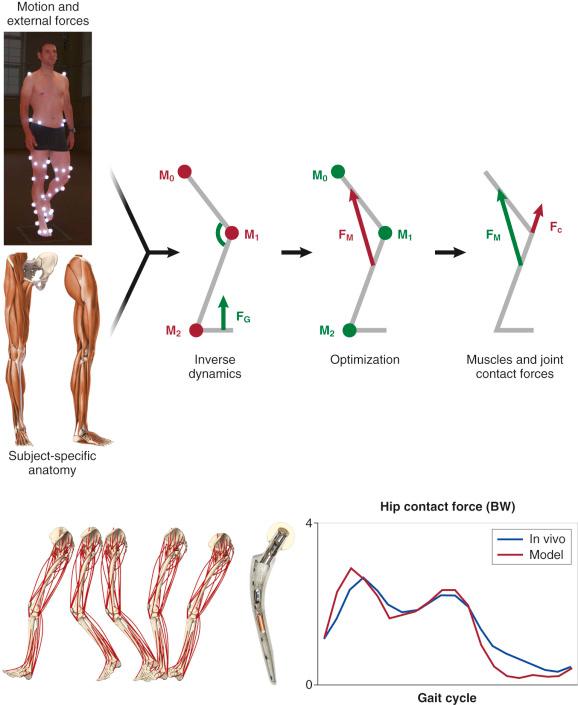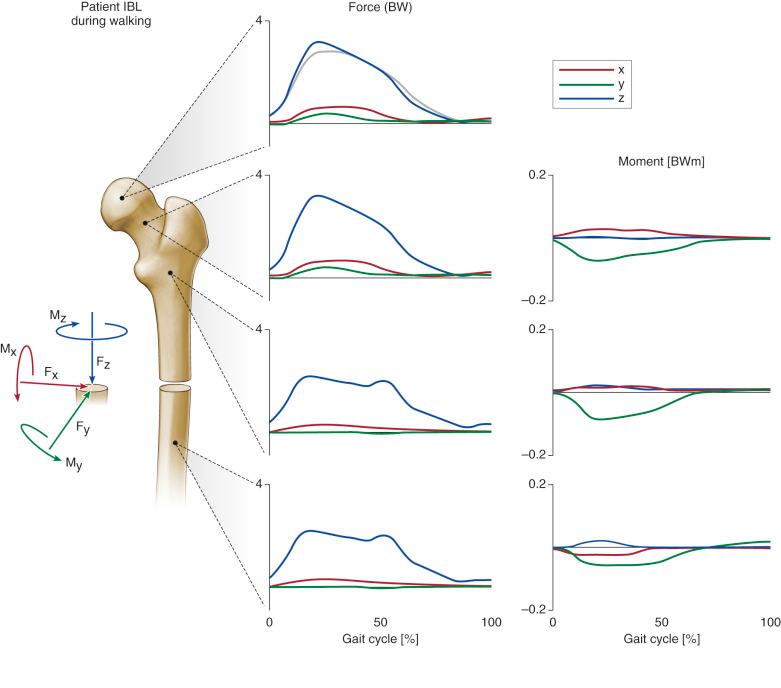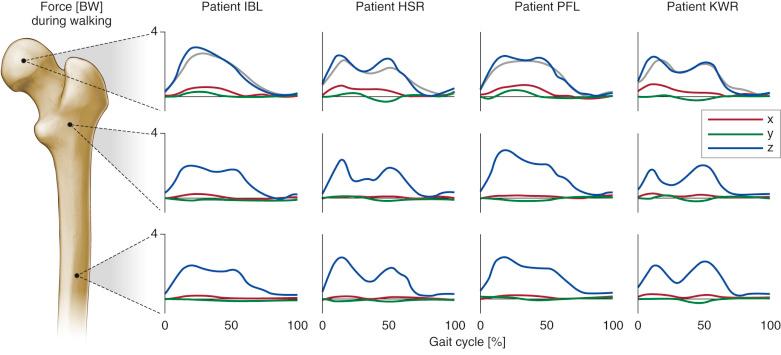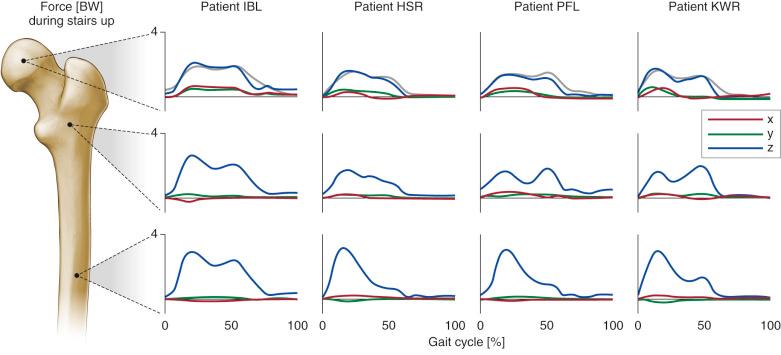Physical Address
304 North Cardinal St.
Dorchester Center, MA 02124
Muscle forces play an integral role in the loading environment of the hip. If the mechanical role of major muscles is neglected in biomechanical analyses, joint contact forces tend to be underestimated, the tensile and compressive strains in the femur are often overestimated, and torsional effects are mostly underestimated.
Restoring the hip center to its anatomic location, specifically mediolaterally, is essential for minimizing the contact forces in the hip joint and avoiding adverse side effects.
Proper orientation of femoral stems is essential for long-term performance in total hip arthroplasty (THA). For cemented stems, anteversion plays a more important role in determining cement mantle stresses than prosthesis offset. Therefore it can be considered a more influential parameter affecting the long-term clinical outcome of primary THA. Changes in femoral implant orientation and design can cause substantial increases in cement stresses, most importantly in critical regions such as the calcar.
A combination of increased offset and anteversion of the femoral stem can produce critical cement stresses, especially during stair-climbing activities. Care should thus be taken to avoid increases in femoral anteversion, particularly when using cemented stems with a large offset, where large femoral anteversion angles should be avoided.
Use of a short-stemmed implant can facilitate minimally invasive surgical approaches, but despite the concept of proximal anchoring, stress shielding still occurs even with short-stemmed implants.
Malposition of a cementless short-stemmed implant leads to only small changes in the internal loads within the proximal femur provided that only moderate changes are made in the anteversion or effective offset of the femoral stem. Much larger changes in the cortical strains generally result from the implantation of the prosthesis.
In cases of dysplasia-associated secondary coxarthrosis with pathologic anteversion of the femoral neck, the use of short-stemmed implants can be, from a biomechanical viewpoint, somewhat critical, since the possibilities for anatomic reconstruction of the anteversion are limited, possibly favoring high hip contact forces and large loads in the femur.
Long-term survival of an artificial hip joint is influenced by the prosthesis design, quality of the surrounding bone stock, degree of patient activity, and surgical aspects, such as the orientation of the implant components. Furthermore, modifications in joint geometry secondary to total hip arthroplasty (THA) impact joint function, primary stability, and bone remodeling. To improve the long-term survival of hip joint replacements and to minimize rehabilitation time, a fundamental understanding of the joint's biomechanics is necessary. This becomes even more relevant for revision cases, as the geometry of the hip can differ from the preoperative condition and therefore can lead to significantly altered mechanical boundary conditions in the joint. During THA, surgeons often aim to optimize function and loading conditions through specific geometric alterations of the musculoskeletal structures. However, without detailed knowledge of in vivo musculoskeletal loading, neither the short-term nor long-term consequences of these intraoperative alterations can be accurately predicted.
This chapter aims to provide a basic understanding of THA biomechanics and to assess the influence of altered geometry of the hip joint. The complex biomechanical analyses introduced in this chapter may be difficult to apply in daily clinical practice; nonetheless, the understanding of basic musculoskeletal mechanisms can help the surgeon to include biomechanical principles in patient treatment. This chapter also aims to raise awareness of the importance of preoperative planning for THA. While consideration of geometric aspects is a common part of joint reconstruction, planning tools or even navigation systems that consider THA biomechanics are not a routine component of clinical practice.
To comprehend fully the biomechanical consequences of changes in joint geometry, an appreciation of the internal loading conditions of the joint must be gained first. Load transmission through the joints and into the long bones has long been considered of importance for clinical evaluation and biomechanical analysis. However, illustrations of the loading conditions in the femur are often oversimplified by displaying only the hip contact force acting on the femoral head. This gives the impression that forces are transmitted through the bone and “leave” the bone at its distal end. This concept has widely influenced the design of experiments for fatigue testing, evaluation of the primary stability of THA implant components, and bone remodeling analyses. As described later, in vivo measurements and numerical analyses of musculoskeletal loading show that load transfer is modified along the entire length of the bone through the continuous action of muscles. Therefore, to understand the load in the femur, this original misconception should be revised to consider the close relationship between joint contact forces and muscle action.
Knowing the external loads on the body and their corresponding internal counterparts is essential to gain more detailed information on the loads that a THA must bear. These internal and external loads define the mechanical boundary conditions in the joint; thus, this knowledge also provides the basis for investigating and understanding the biologic processes during bone healing and remodeling.
In 1870, Julius Wolff described, for the first time, the interrelationship between loading, stress, and strain in bony structures, which he later developed into the so-called Wolff's Laws. Based on Wolff's investigations, Koch published the first analytic determination of the loading conditions in long bones. The remarkable role that muscles play in the loading scenario of long bones was first described later by Pauwels. Using the abductors and the iliotibial tract, Pauwels illustrated the way in which muscle forces reduce internal loading within the bone. In numerous examples, Pauwels also described how muscles and tendons counteract the bending moments generated at the hip through the action of the body weight by examining areas of tensile and compressive strain within the cross-sections of long bones.
While it is now known that the contribution of the muscles is essential to describe the mechanical loading of bones, the actual muscle forces occurring in vivo are hardly accessible. Direct measurement of the coordinated action of all muscle forces in vivo is impossible, as ethical considerations discourage the use of invasive methods in humans. Therefore the only opportunity to estimate the complex distribution of muscle forces is offered by computer analysis.
Optimization algorithms have been employed to identify how forces are distributed among the muscles and to understand what muscle forces drive the loading conditions at the hip. A common approach to validate these models is to compare muscle activation patterns obtained from computer simulation with measured muscle activities as determined by electromyography. However, this method does not allow quantitative validation of the musculoskeletal loading conditions. Instrumented implants provide hip contact forces for different activities for individual patients in vivo. An additional method of validating the predicted musculoskeletal loading conditions is to compare the calculated hip contact forces with these in vivo measured forces. Hip contact forces measured with instrumented prostheses have been compared to the results of computer modeling in the same patients by Brand and coworkers and Heller and coworkers. Brand and colleagues measured hip contact forces 58 days postoperatively, while gait analysis was performed 90 days postoperatively. Therefore a cycle-to-cycle comparison of measured and calculated hip contact forces was not possible. Heller and coworkers used a cycle-to-cycle comparison of measured and calculated hip contact forces to provide a basic understanding of the biomechanics of the artificial hip joint.
To describe musculoskeletal loading conditions analytically within the body, the movement of the extremities and the external loads must be known. This information can be gained from gait analysis, in which the movement of the lower extremity and ground reaction forces on the feet can be measured in large patient cohorts. Based on this individualized measurement of movement and external loads, the resulting joint reaction forces can be calculated using an inverse dynamics approach. Here, these joint loads are the sum of all forces and moments at the joint generated by muscular activity. Using optimization algorithms, a reasonable solution can be found for a pattern of muscular activity that can balance these forces and moments. However, these mathematical analyses must be validated against in vivo data to verify the plausibility of the results. One option to gain such in vivo data is the use of telemetric implants as developed by Bergmann and colleagues, for example.
Heller and coworkers followed such an approach in their study and verified their results calculated with a musculoskeletal model to hip contact forces measured with telemetric hip implants. A full description of the musculoskeletal model of the lower limb, muscle, and joint contact force calculations and the collection of gait data can be found in the literature but can be briefly summarized as follows. Four THA patients with telemetric prostheses were studied; the patients were 11 to 31 months postoperative at the time of the study. In all 4 patients, individual anatomic measures were determined from computed tomography (CT) scans and radiographic data (e.g., pelvic width and depth and femoral, tibial, and foot length). In addition, neck-length, neck-stem, cervicodiaphyseal and anteversion angles were recorded. Gait analysis data (i.e., ground reaction forces, limb segment positions, velocities, and accelerations) for walking and stair climbing were determined simultaneously with in vivo hip contact forces. A computer model of the human lower extremity (CT data, Visible Human, National Library of Medicine, Rockville, MD), including bone surfaces and muscles, was developed ( Fig. 2.1 ). Where appropriate, muscles were wrapped around bony contours. This model was then scaled to match the individual anatomies of the 4 patients. Muscle and joint contact forces were calculated throughout the gait cycle for both walking and stair climbing using an optimization algorithm, which minimized the sum of muscle forces. For validation, hip contact forces calculated for individual gait cycles were compared directly to the corresponding in vivo measurements, showing good agreement.

Utilizing such validated musculoskeletal models, THA biomechanics can be explored in more detail. Variations in parameters describing the anatomically reconstructed hip can be simulated using the computer model, including variations in component placement and orientation. Furthermore, while in vivo measurements provide limited data describing the internal forces acting at a single location, musculoskeletal models that predict muscle and joint forces throughout the entire extremity provide a means to analyze the loading conditions throughout the entire bone.
The musculoskeletal model applied to the 4 patients with telemetric THAs has revealed that the internal loading of the femur is predominantly characterized by axial compression ( F z ) with small mediolaterally ( F x ) and anteroposteriorly ( F y ) oriented shear forces ( Fig. 2.2 ). During walking, both the compressive and shear forces are largest at the femoral head and decrease distally toward the diaphysis. This is related to the relatively large activity of the abductors during gait. The bending moments in the femur are dominated by the frontal plane bending moment ( M y ); axial torsion ( M z ) is the smallest of all moments (see Fig. 2.2 ).

Even though the patterns differed over time because of the patients' individual gait characteristics combined with their postoperative rehabilitation, the load magnitudes appeared to be comparable among the 4 patients during walking ( Fig. 2.3 ) and stair climbing ( Fig. 2.4 ). However, large differences were found in the magnitudes of the compressive forces acting down the femur ( F z ), where during stair climbing the forces peaked in the diaphyseal part of the bone owing to contraction of the vasti. Patient-specific loading characteristics were also apparent. Variation existed throughout the length of the bone. The importance of considering the muscle contribution when analyzing the mechanical loading is underlined by the fact that the bending moments determined were considerably smaller compared to those predicted by previous analyses that neglected muscle forces.


Generally, the analyses revealed that the higher hip contact forces occurred during stair-climbing activities than during level gait in all 4 patients , corresponding to larger internal forces and moments. However, fast walking causes forces at the hip joint that are higher than during stair climbing. The general ratio of compression to shear forces and bending to torsional moment remained similar throughout. The literature suggests that specific situations, such as stumbling, can cause excessive hip contact forces. The analysis of musculoskeletal interaction suggests that under such a condition, muscle activity alone is capable of generating extreme joint forces. Similarly, all other bony regions spanned by the activated muscles may become excessively loaded during activities such as stumbling. If muscles are activated to their full potential, they may produce not only maximal forces at the joints and extreme compression forces in the bone but also excessive bending and shear forces. In THA patients, such high contact forces and bony loads may endanger the bone implant interface and the longevity of the implants, as discussed later.
Become a Clinical Tree membership for Full access and enjoy Unlimited articles
If you are a member. Log in here